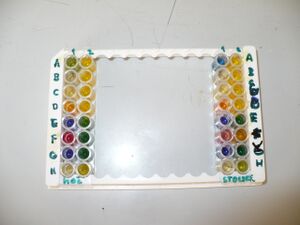ENTEROtest
ENTEROtest is a method used to distinguish and determine the type of bacteria.
Principle[edit | edit source]
Bacteria are specific in their requirements for the environment in which they live, which means that they use different substances, but each substance is always specific to that bacteria (eg carbohydrates, proteins ...). We are able to detect a given bacterium according to the use of various substrates.
Appearance[edit | edit source]
ENTEROtest is a plate containing 16 wells with dehydrated solutions. Each well contains a different chemical that changes color. This is used to read the test result.
Execution[edit | edit source]
Insert the biomass containing the microbe into the test tube using the inoculation loop. Pipette 2 μl of solution from a pre-prepared tube into each well. Be careful not to touch the tip of the micropipette with the dehydrated mixture when replacing the tip. Finally, we coat the designated wells with the specified oil (according to the manufacturer's conditions) to simulate the anaerobic environment. We cultivate for 24 hours at 37 ° C.
Deduction of results[edit | edit source]
After 24 hours, inspect the ENTEROtest and use the scorecard (attached to the ENTEROtest) to determine each well as positive or negative (depending on the color of the well). According to these results found in the Result Book (located in each laboratory using ENTEROtest), we determine the microbe.
Links[edit | edit source]
Related articles[edit | edit source]
External links[edit | edit source]
Source[edit | edit source]
- MOŠKO, Tibor. Mikrobiologické testy [přednáška k předmětu Mikrobiologie 2, obor Všeobecné lékařství, 1. LF Univerzita Karlova]. Praha. 10.10.2016.



